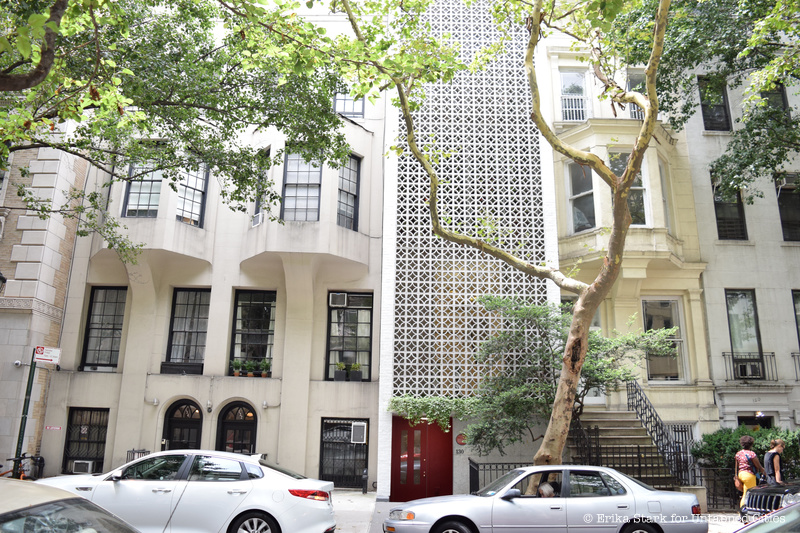
Although the Upper East Side has had reputation of possessing an elitist air of finery and glamour over the course of New York’s history, it has been welcoming a more diverse group of folks over the last few years, attracted by lowering real estate prices.
Encompassing the entire East Side of Manhattan (from Central Park to the East River) and between 59th and and 96th streets, the Upper East Side covers a little more than its fair share of Manhattan. While the different colors of these blocks might hide in the shadows of New York City (and world) staples such as Museum Mile along Fifth Avenue or the host of expensive, internationally recognized eateries and shops, the Upper East Side is a tapestry woven of many different threads – not just spun gold. From hole-in-the-wall hobby shops and German butcheries, to world-famous bars and churches, the Upper East Side is full of hidden gems, both historical and contemporary, worth a trip weaving through the 250 blocks.
Here are 22 of the some of the most must-visit places the Upper East Side has to offer.
Historical Sites
Temple Emanu-El
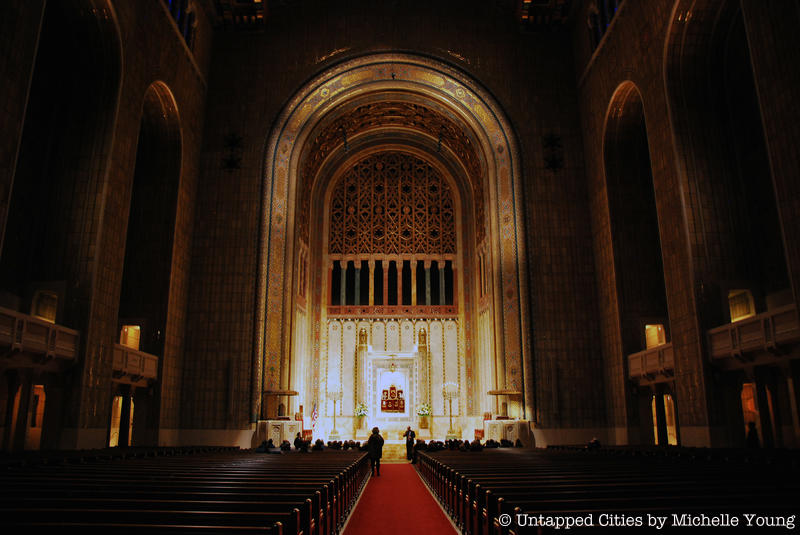
The Upper East Side is home to Temple Emanu-El, the largest Reform temple in the world and one of the largest of any Jewish denomination. The roots of Temple Emanu-El can be traced back to 1845, when a small group of 33 German-Jewish immigrants held the temple’s first reform service in a second floor loft at the corner of Grand and Clinton Street on the Lower East Side. Throughout the 19th century as more German-Jewish immigrants flowed into New York City, the congregation relocated four more times until it finally settled in its current location at Fifth Avenue and 65th Street in 1929, which it constructed after merging with Temple Beth-El two years earlier.
Still hailed as one of largest and most beautiful synagogues in the world, Temple Emanu-El can seat 2,500 people in its main sanctuary, which measures 103 feet high and 100 feet wide. Even more impressive is the fact that the synagogue’s architectural steel frame, designed by architectural firm Kohn, Butler & Stein, allows the enormous hall to stand pillar free. With 60 stained glass windows, a multihued ceiling that’s hand painted and gilded, and the largest synagogue organ in the world featuring over 10,000 pipes, Temple Emanu-El is one building that every New Yorker should have on their radar.
Gracie Mansion

Gracie Mansion was originally built in 1799 by merchant Archibald Gracie, and was acquired by the city of New York in 1896. That same year Gracie Mansion was incorporated into the 11-acre Carl Schurz Park where it still stands today. For nearly 50 years under the ownership of New York City, Gracie Mansion was used for a variety of odd functions including a concession stand, restrooms for the park, and classes for immigrants. Then, in 1923 it became the first home to the Museum of the City of New York. It served as the museum’s space until January 11, 1932 when the institution relocated to its Fifth Avenue building. After that, the NYC Department of Parks converted it into a historic house museum. Then in 1942, Gracie Mansion assumed its current role as home to the mayor of New York with Mayor La Guardia as its first mayoral resident.
As such a historical and diversely used space, naturally Gracie Mansion has quite the list of quirks and intriguing stories– many of which involve Archibald’s business partner: Alexander Hamilton. In fact, during one business meeting on the porch of Gracie Mansion, Hamilton along with other members of the Federalist Party founded the New-York Evening Post– the paper which would eventually become the New York Post. Gracie Manison is also connected to Hamilton’s demise as well. After his infamous duel with Aaron Burr, Hamilton was brought to the Bayard House of a prominent Anglican family on Jane Street in the West Village. It was in that house in front of the fireplace the fatally injured Hamilton spent his last moments before dying the next day on July 12th. The fireplace was installed in Gracie Mansion’s ballroom in 1966.
Today, visitors can still see the sights of these historical events through the Gracie Mansion Tours, as well as all the work that’s been done and contributions that have been to the home since. Among one of the more notable is “Windows on the City: Looking Out at Gracie’s New York,”: a permanent art installation added to Gracie Mansion in 2015 by Mayor Bill de Blasio. The installation is filled with pieces of art from the Gracie Mansion construction time period “to create a more historically accurate picture of life in New York City during the time of Gracie Mansion’s construction,” including The Gradual Emancipation Act. On the horizon for Gracie Mansion is the ambiguous, but none-the-less, upcoming plans by the The Gracie Mansion Conservancy for the historic home’s 75th anniversary.
For more information on the interesting anecdotes that surround this home, check out our list of Gracie Mansion secrets.
Jean Baptiste Catholic Church
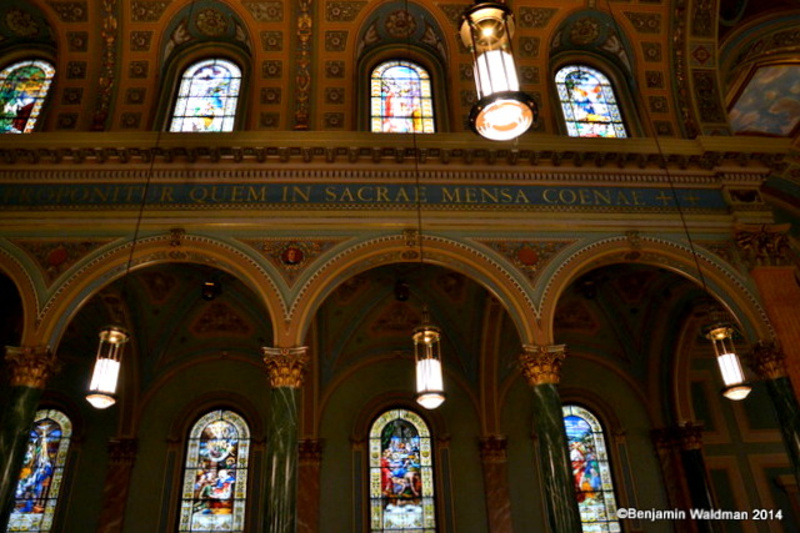
Another Upper East Side historical relic is yet another religious beauty: the St. Jean Baptiste Catholic Church. Located on Lexington Avenue, between 75th and 76th Streets, St. Jean Baptiste Catholic Church was founded in the 1840s by French Catholics in New York and they brought some remarkable stained glass windows with them from Chartres, France. To this day, it is the only Catholic Church with Chartres windows in New York City. The building was designed a New York City landmark in 1969.
Among the other breathtaking Renaissance architectural details of the church are the classic Renaissance-style dome, arches and fluted pilasters, three naves, and the twin towers surmounting the facade. The Church’s facade was supposed to contain an “imposing Arch-of-Triumph portico, supported by four gigantic columns, and an impressive approach of church-wide steps,” according to the official Jean Baptiste website. However, the widening of Lexington Avenue resulted in its removal.
Parks
Gardens at the Frick Collection
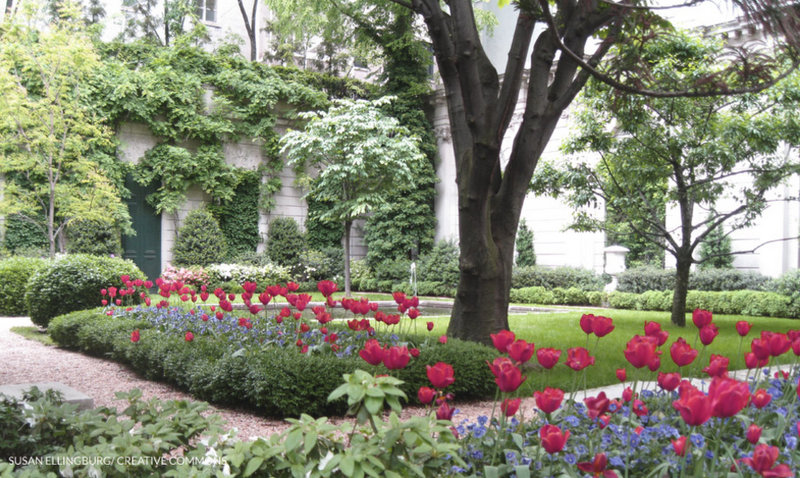 Imgae by Susan Ellingsburg/Creative Commons
Imgae by Susan Ellingsburg/Creative Commons
The Frick Collection, located in Henry Clay Frick’s former gilded-age mansion, is a historical and cultural wonder in it of itself (not to mention home to world-class European art), but the gardens at The Frick Collection are equally enjoyable. Alongside the art and sculpture, visitors to the Frick Collection can experience both the Fifth Avenue garden as well as an internal, gated garden in the courtyard of the mansion.
Though the Fifth Avenue Garden is closed to the public, it serves both a practice and atmospherical purpose for The Frick Collection. The rose beds supply the fresh flowers in the galleries and the herbs grown there are used to season the food. Then as the Frick Collection states, “Set back from the sidewalk, behind the tall fence guarded by mythic iron griffins, the raised garden is presented like the stage of a theater, separating it from the busy world. Likewise, viewing the garden from the windows of the Fragonard Room or the Living Hall visually integrates the art and gardens in a way no other museum in the city can.” The exception to the garden’s public closure is The Frick Collection’ s annual Garden Party– a fundraiser and one of many perks to Frick Fellows (fellow status obtained starting at $1,500).
The even more tucked away 70th Street garden, designed by notable landscape designer Russell Page, was recently the locus of controversy. The original proposal for The Frick Collection’s 2015 renovations called for removal of the courtyard and accompanying entrance pavilion to create more space for installations. Thanks to community-led activism, the courtyard was saved.
The Garden Court, however, remains open to the public year round as almost interactive, permanent installation of The Frick Collection. Located in the courtyard of the mansion, it was designed by John Russell Pope to replace the open carriage court of the original Frick residence. The Court’s paired Ionic columns and symmetrical planting beds were echoed in Pope’s later designs for the original building of the National Gallery of Art in Washington, D.C. Check out The Frick Collection’s virtual tour of the courtyard for a cyber-sense of what it has to offer.
Additionally, just this past month The Frick Collection expanded their pay-as-you-wish hours. Now, New Yorkers and visitors are welcome to donate at their leisure on Wednesdays, from 2 to 6 PM. in addition to the previous free admission on Sundays, from 11 a.m. to 1 p.m. and monthly First Friday’s from 6 to 9 PM
The East River Promenade
 A rendering of the promenade’s proposed future design via the Office of the Mayor.
A rendering of the promenade’s proposed future design via the Office of the Mayor.
The East River Promenade, a paved brick pathway running roughly 1.5 miles along the East River Greenway, is a path designed for pedestrians to take a stroll or for cyclists to ride with East River views (minus distraction of street traffic). The Promenade was closed for almost a decade before reopening back in 2012, with those renovations turning what New York City Department of Parks and Recreation called, “a longtime urban blight,” into, “one of the best vistas in the city.” The walk also features sights of Triborough and Hell Gate bridges, unobstructed views of Roosevelt Island, and a passing of Gracie Mansion.
Though the promenade and FDR Drive have an intriguing past, even more exciting is the park’s future. A new esplanade will be built between 53rd Street and 61st Street, with the design phase commencing this year and construction completed by 2022. This important stretch at the southern end of Sutton Place South will add access to the waterfront where currently apartments sit elevated above a covered portion of the FDR Drive, and continuing under the Queensboro Bridge, to the abandoned rollercoaster-like structure at 61st Street, an art installation by Alice Aycock from 1994. The new esplanade will be built over the East River, and initial approvals have already been obtained from the US Coast Guard, Army Corps of Engineers, and State Department of Environmental Conservation.
Modern Architecture
The Halston House
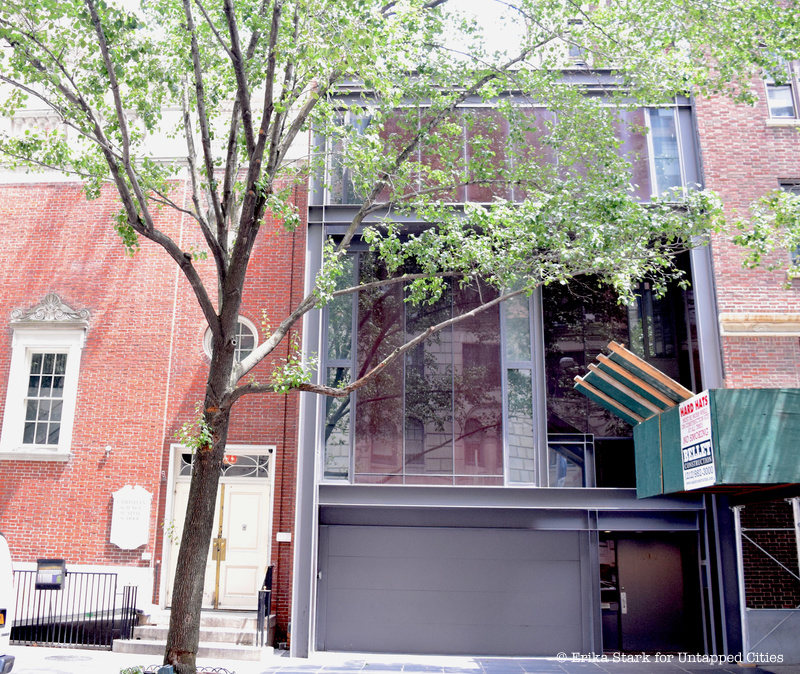
The home at 101 E 63rd St, also known as The Halston House, looks sleek and unassuming from its outdoor facade. This was the intent of the architect Paul Rudolf, who is most reknown for his design of the Yale Art and Architecture Building (A&A building). Rudolph applied his trademark, Brutalist style of complex floor plans and concrete into The Halston House (one of only three residences he designed in Manhattan). The 1967 home was built for real estate lawyer Alexander Hirsch and his partner, Lewis Turner. The purposeful seclusion of the front of the home was to achieve what Rudolf sought in all of his designs: to be a hideaway from the constant movement of the city. He “made sure his clients would live in what one critic referred to at the time as ‘a world of their own,’” as New York Magazine once reported.
However, not many years later, acclaimed American fashion designer, Roy Halston Frowick bought the 75,000-square-foot-house for himself, doing away with the seclusion in favor of lavish parties. Among some of the most notable to grace the home’s floating steps and walk amongst the attached 1,600-foot terrace are Eliza Minelli, Jackie O, Andy Warhol and the rest of the Warhol gang. Today, the 4 bedroom, 5 bath home is up for sale and on the market for a mere $28 Million.
Asphalt Green
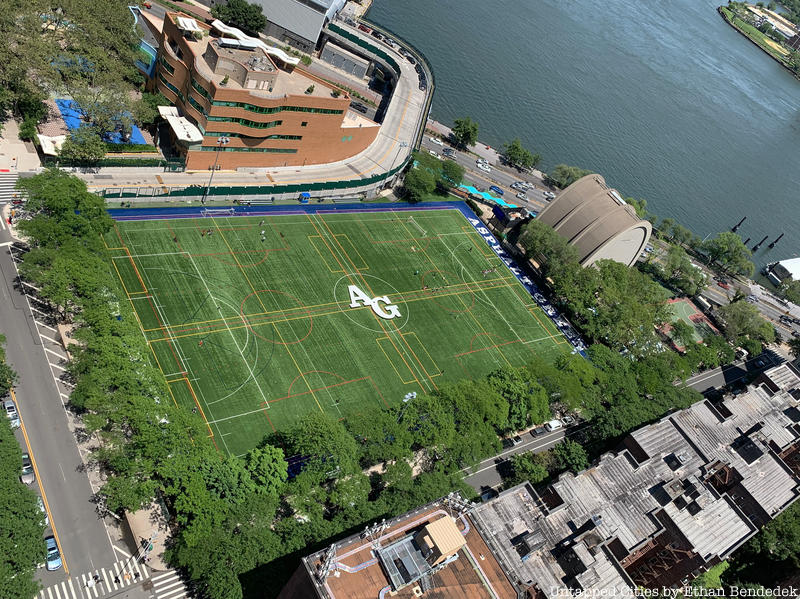
Another modern marvel to check out is Yorkville’s Asphalt Green Park. Located on the spot where the asphalt of New York roads was first mixed back in 1914, the building has since been deemed the “Cathedral of Asphalt.” However, that ode wasn’t necessarily what the architects, Robert A. Jacobs and Ely Jacques Kahn, had in mind when they designed the building during World War II. The inspiration instead came from the design of old French airports of the mid-’30s. Additionally, the sundial at the front of the building is itself a piece of sculptural modernism. “Song to the Sun” is scaled to the parabolic building behind it and was constructed by Robert Adzema, to “elevate the spirit as it rises up to celebrate and bring sun and sky to this urban plaza.”
Controversy over the merit of Asphalt Green erupted since its inception, but despite being condemned by Robert Moses as “the most hideous waterfront structure ever inflicted on a city,” the park was hailed by The Museum of Modern Art as a masterpiece of functional design. Then, in the early 1970’s, Asphalt Green was once again slated for destruction until efforts to save it were championed by Cornell Professor Dr. George E. Murphy and his wife Annette Murphy in 1972. Although it’s been many a year since the modern building served as an asphalt plant, today, Asphalt Green continues to operate as it was intended by the Murphy’s– as an affordable, community health and recreation facility.
The Edward Durell Stone House

Just around the corner from The Halston House lies another piece of modern living. Located at 130 E. 63 Street, The Edward Durell Stone House was transformed from a simple 1878 brownstone into the icon of modernism it is today when MoMA architect, Edward Stone, first started tampering with his residence. In 1956, Stone, added a skylight, took out all the interior walls, built a class-covered patio and added the latticed layering that now covers the entire front of the building. These features, combined with the fact that the latticing wouldn’t be allowed to be replicated today even if someone wanted to, make it truly one-of-a-kind.
As one walks up to the front door, a simple red plaque lies just to the right of the entry way, informing passerbyers to the landmark status of the home and reminding people of Stone’s unique take on the modernist movement. It reads: “Stone later rejected the austerity of modernism and sought to create a warmer, more decorative modern architecture in projects such as the US. Embassy in new Delhi, India, the John F. Kennedy Center for the Performing Arts in Washington D.C., the Gallery of Modern Art on Columbus Circle (now the Museum of Arts and Design, following controversial renovations), the General Motors building on Fifth Avenue, and this townhouse, which he renovated in 1956, and where he lived until 1964.”
Last put on the market in 2014, the 15-foot-wide, almost-completely-open home was set at $9.95 million.
Cultural Sites
Treasures in the Trash Museum
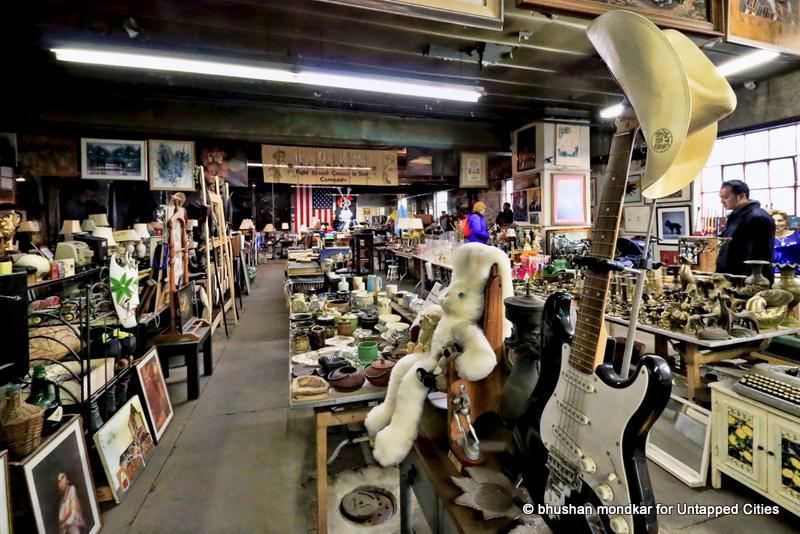
In East Harlem at DSNY Sanitation Garage 11 located at 343 East 99th Street, is a trash collection that would rival Ariel’s treasure trove in The Little Mermaid. Sanitation engineer, Nelson Molina has been curating trash for over thirty years for the “Treasures in the Trash Museum,” as he calls the collection, housed in the sanitation garage. The collection, which features over 50,000 “found items,” were all gathered by Molina on the job during his time with the Sanitation Department.
Molina says that more than 90 percent of the objects were collected from his DSNY route in Manhattan’s 11th District, between 96th Street and 110 Street and between 1st and 5th Avenues. The items in the museum are laid out and organized into themes, including a table of typewriters, a section with baseball paraphernalia and a variety of chairs. One of several installations created by Molina throughout the gallery is a wall of posters and maps of Central Park featuring quotes from the East Village artist De La Vega. The recurring quote featured in this installation says “Become Your Dream,” one of the many sayings that La Vega would write on garbage around the city as part of his art. Another notable treasure the museum also features is a Star of David commemorating a man who lost his life on 9/11 which was forged from the metal of the World Trade Center. See more photos inside the gallery here.
Barbizon Hotel for Women

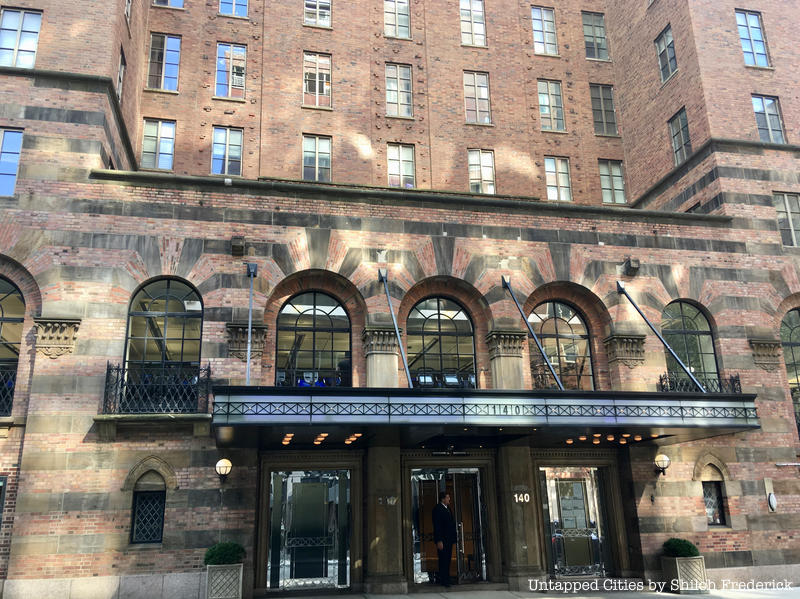
Located at 140 East 63rd Street, The Barbizon hotel’s story begins in 1926 when it was built as a “Club Residence for Professional Women.” It wasn’t until the 1940s that its reputation blossomed as the hotel for young single and gorgeous women. There were other hotels in New York City specifically for women, but the Barbizon stood apart, namely due to its exclusivity. A woman had to have three letters of recommendation along with impeccable manners and dress in order to be allowed a room at this dormitory style hotel.
Between 1940-1960, Joan Crawford, Grace Kelly, Liza Minnelli, Cybill Shepherd, Candice Bergen, Joan Didion, and Betsey Johnson made the Barbizon their home. Eileen Ford, who ran the Ford Modeling Agency, regularly rented rooms at the Barbizon for many of her models. In the April 2010 issue of Vanity Fair, the author Michael Callahan describes it well, “If the Barbizon had a face, it was that of Grace Kelly…The Barbizon wanted its poster girl to be Lisa Fremont, Jimmy Stewart’s sophisticated girlfriend in Rear Window, who had all of Kitty Foyle’s snap and guile, but was also swathed in filmy negligées, A-line dresses, opera gloves, and smart pillbox hats with netting.”
Cool Streets
Henderson Place
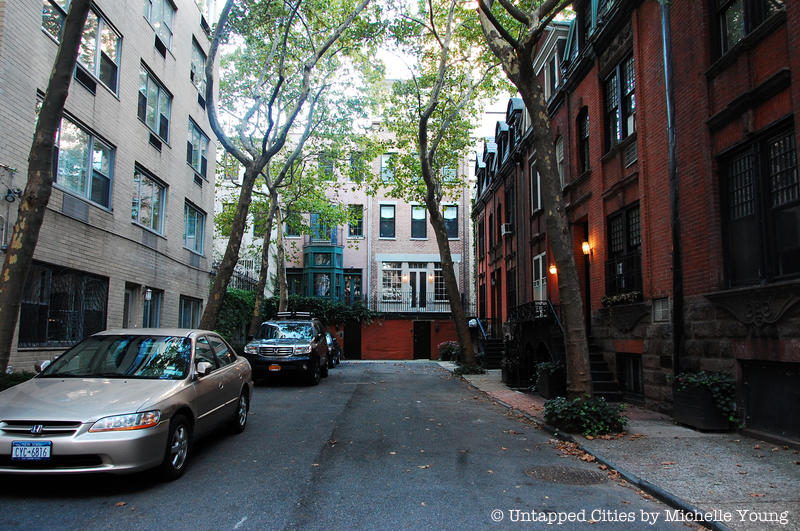
Henderson Place, located on 87th Street between East End Avenue and York Avenue, is a Historic District – and one that’s only one block long. Henderson Place is a private road, clearly noted with a permanent sign and three road blocks (which also request no dogs). The Queen Anne style homes were once part of a larger development of 32 houses– eight of which have since been demolished.
The Landmarks Preservation Commission designation for historical landmark included the following:
“[The Queen Anne style] was a very personal style and depended largely on individual taste. Because it had such quaint and picturesque qualities, full freedom was permitted in the juxtaposition of otherwise disparate elements. This appealed to people who were looking for something both fanciful and novel. John C. Henderson was one of these. In 1880 he selected the architectural firm of Lamb & Rich (Charles A. Rich, 1855-1943 and Hugo Lamb, 1848-1903) to design this intimate group of residences. The project was virtually completed by 1382. The houses were intended to be sold to ‘persons of moderate means,’… What is even more remarkable than the general overall effect of uniformity is the charm and variety achieved, within the framework of moderate, cost. Using elements of “Queen Anne” design, each house, with its minor variations, might be said to be freely improvising on a stylistic theme. The resulting effect is one of overall coherence with picturesque overtones.”
The houses along East End Avenue are also included in the historic district. Some famous residents have included the Duke and Duchess of Richelieu and editor at the then New York Evening Post and war correspondent Horace Green.
Bird House Row
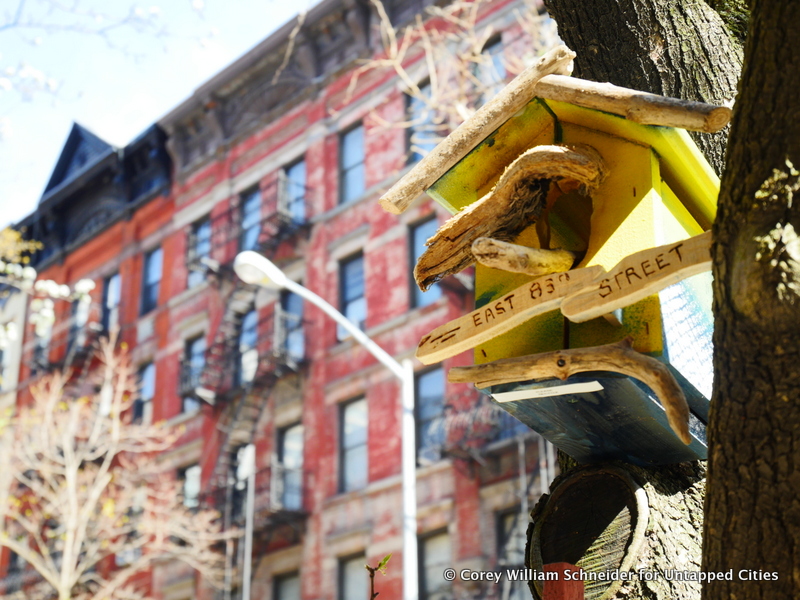
On 83rd Street between York Avenue and East End Avenue, 22 unique and colorful birdhouses mysteriously popped up on the Upper East Side in 2016. Like the dramatic birdhouses in Greenwich Village, the ones here feature many fun architectural and ornamental details. Many of the birdhouses have addresses, names or phrases included on them. Some say “Home Sweet Home,” or “Peace Understanding,” others say “East 83rd Street” or specific addresses on 83rd Street or “Uptown.”
The bird house creator, known to be a man with the code name “Woody,” is keeping his identity anonymous but the lucky gift recipients of the birdhouses spoke to the media in the wake of their appearance. Many of them include natural and knotted bark. “Woody” also takes care of the birdhouses, tending “to the block’s tree pits, keeping them tidy and fixing them when they need it.” As he told CBS back in 2016, he sees his role here as a “Good Samaritan.”
For a complete look at all the birdhouses, check out our previous article.
Shopping
Tender Buttons
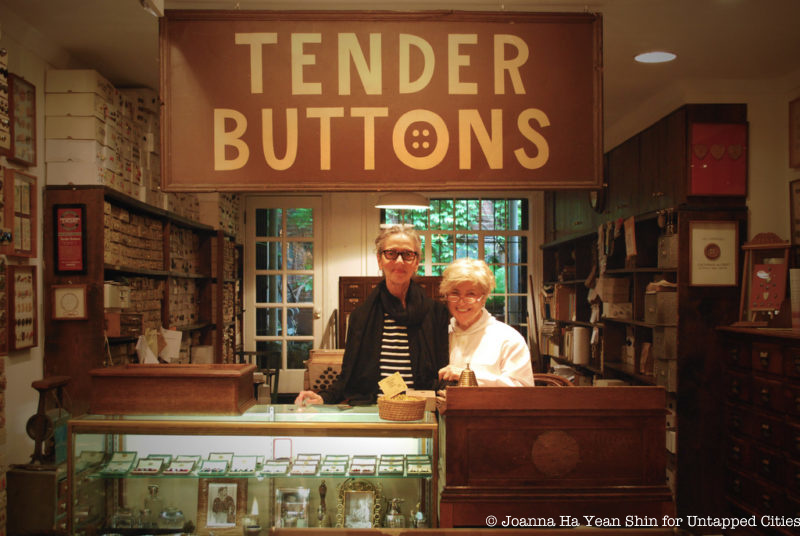
In a neighborhood dominated by Bloomingdales and other big retail stores, there is one shop around the corner on East 62nd Street that defines a different type of high-end shopping. The shop Tender Buttons between Lexington and Third Avenue shifts the priorities of value by emphasizing not on the mass-manufactured, bigger-is-better attitude, but on the personalization of the things that matter — buttons.
The slim, brownstone building reveals a charming window display beneath one large button that used to be pink, but now glimmers in gold. This signature button is the logo of Tender Buttons and is also one of the many millions of buttons sold in the store. The narrow interior houses countless buttons ranging from the 17th century to the present day, and all of the furniture in the store is also antique, including the desks the clients can sit at to sift through buttons and find a perfect match.
The Tender Button’s building itself also has a rather storied past, and is one of the narrowest in Manhattan at 12.6 feet wide. In 1929, Dorothy Caruso, the widow of Enrique Caruso, set up the Dorothy Caruso Reproducing Studio in this building, making personal phonographs–a precursor to the modern recording studio. Interestingly, she catered to more than music–recording anything from a greeting to a sales letter. The space was renovated in 1950 and a home decor store moved in. This area remains a mini-enclave for home decor stores and of-course, unique shops like Tender Buttons.
For more on the shop, read the rest of our previous Tender Buttons profile: Cute As a Button: the story of Tender Buttons.
Jan’s Hobby Shop
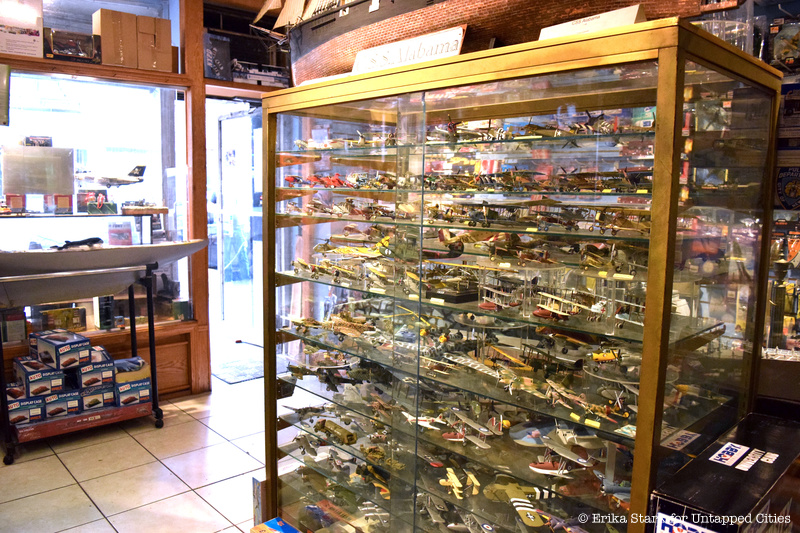
A whimsical treat for anyone walking along Lexington Avenue just before the 96th street station is a quick (or maybe lengthy) stop in Jan’s Hobby Shop in Yorkville. The shop, which is filled mostly with miniatures of all types– model trains, planes (allegedly over 1,000) boats and toy soldiers– along with other activities such as paints and puzzles, is almost as quirky as the face of the shop– Collette Hutchins.
Colette, the very French mother of Fred Hutchins, greets guests with a thick accent of the Lorraine region (the Lorraine dialect being one of four languages she speaks, she might add) and ice-blue eyeshadow while Fred works away in the back, hand-assembling each and every model you see in the store. It was Fred who prompted his parents to buy the shop’s first location– the prior home to the York Avenue hobby-shop–when he was a teenager back in 1973. Though they moved to their current location on Lexington in 2003 for more room than their old shop could provide, the cozy essence of Jan’s remains the same. According to a New York Magazine article, the shop both “attracts hobbyists and parents eager to tear their children away from the television. Many even arrange with (Fred) Hutchins to have model-building birthday parties for up to 10 kids in the store’s dusty dungeon (his only rule: no food).”
Check out Jan’s Monday through Saturday, 10 AM – 6:30 PM or Sunday’s, 12 – 5. Just be prepared to say “goodbye” along with au revoir and Auf Wiedersehen as well on your way out the door.
Restaurants and Food
Lexington Ave Candy Shop
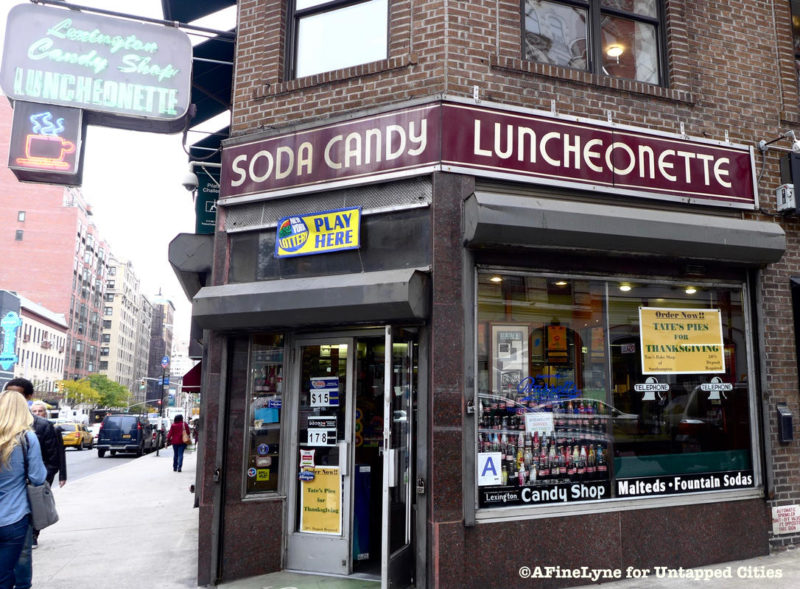
Stepping across the threshold into The Lexington Candy Shop Luncheonette is truly like stepping onto a 1940s movie set and with good reason, since its last renovation was in 1948. Here you will find the oldest family owned luncheonette in New York City. John Philis, the grandson of the original owner, will most likely be there to greet you. Within these walls, tradition is a way of life from the original coffee urns that date back to 1948 to the original Hamilton Beach milk shake mixer from 1940.
The vintage interior has been lovingly preserved down to the smallest details and it’s no surprise to learn that the shop has been featured in numerous movies, commercials and TV shows including Fading Gigolo, Three Days of the Condor and The Nanny Diaries. Their customers have included Sir Paul McCartney, Bruce Springsteen, Matt Dillon, Tom Brokaw and Al Roker–just to name a few.
Its primary customer base, however, consists of locals– many of whom are far younger than the milk shake mixer. The shop can be rented for private parties as well, which includes their full menu and inspired the New York Post to call it, “the latest in party chic.”
Schaller & Weber
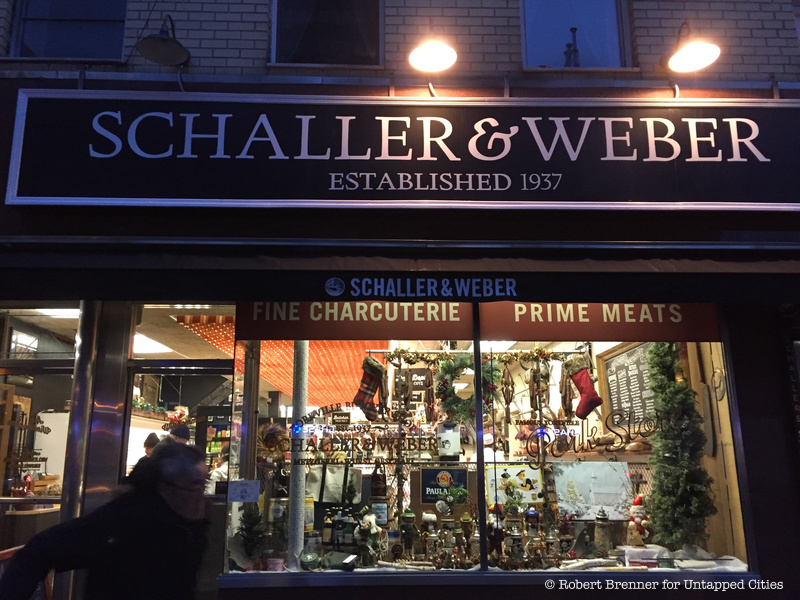
Schaller & Weber, located at 1654 2nd Ave, takes old-school German butchery and sausage-making techniques to Yorkville for the Upper East Side’s very own traditional-German, family-run delicatessen. It all started back in 1918 when Ferdinand Schaller spent five years traveling all of Germany, learning the skill sets of German butchery and charcuterie masters, before taking that knowledge with him to New York City. According to the Schaller & Weber’s official site, at first Schaller held just a cook’s mate position on the first ship out of Germany bound for America, but by the time he arrived in New York City, he was a “master charcuterier so treasured by his shipmates for his cured meats and sausages that he was barely allowed off the ship.”
Since docking in 1927, Schaller met Tony Weber in 1937 and established their shop, and their fame, skills, and then legacy has only grown. According to the site, “Schaller & Weber is the first and only American sausage and meat producer to repeatedly win gold medals of honor at international exhibitions in Holland and Germany.” Today at the shop, anyone’s welcome to stop in and get a taste of the tried and true recipes still made with the exact standards that the shop first began with including, a traditional split pea soup, black forest ham, bockwurst, Choucroute Garni and Kolbase Potato Salad among a handful of others.
“Schaller & Weber. It’s what tradition tastes like.”
Bars
Met Rooftop Garden
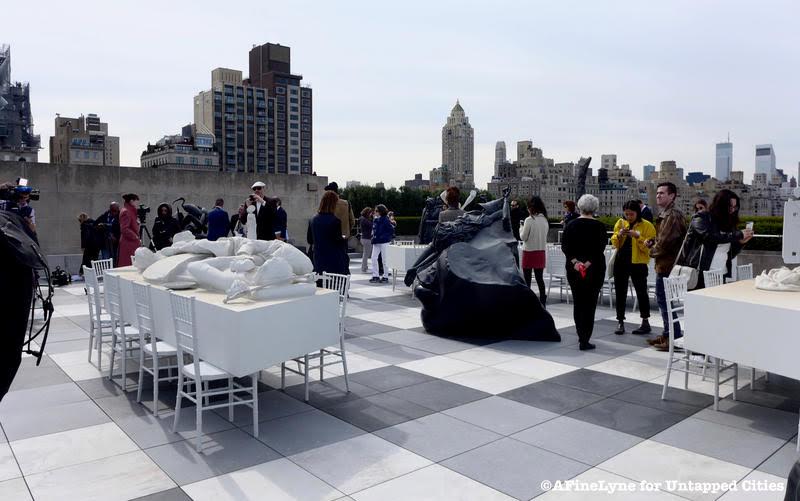
Get boozy with a view at the Metropolitan Museum of Art’s rooftop bar. It’s a rare opportunity to enjoy a drink, a virtually uninterrupted view of the city and ponder whatever display the Met has on the roof at that time (currently, Adrián Villar Rojas’, The Theater of Disappearance, pictured above.)
Technically, the bar is only open to the public when the Met is overflowing, but luckily it’s not rare for the museum to be packed with patrons. However, if you find the bar’s sweeping views of the skyline and Central Park as seductive as it sounds, you can become a Met member and gain access to a members-only location at the bar– open Fridays and Saturdays from 5 to 8 PM through October. (This goes for all members at the “associate level”– $70– and higher.)
Bemelman’s Bar
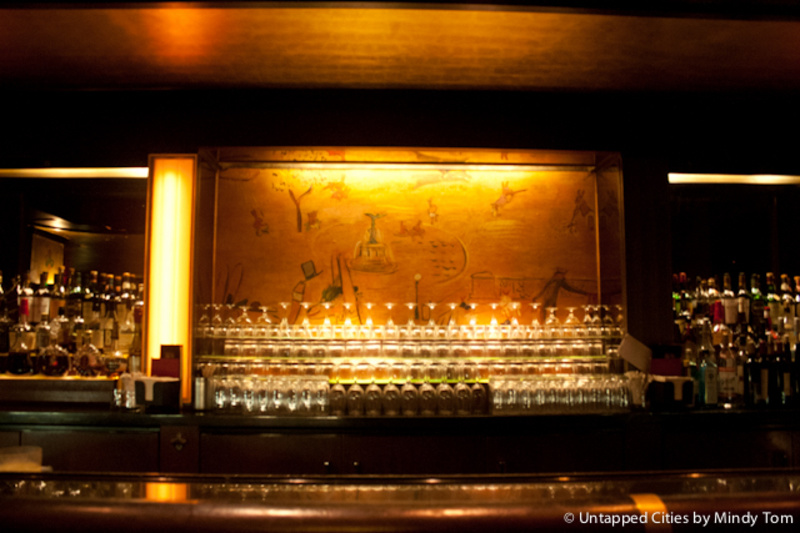
The Carlyle’s Bemelman’s Bar takes both its name and its golden illustrations from the author Ludwig Bemelman– the creator of the Madeline children’s books. Throughout his early career, Bemelman would often trade his work for room and board, as was the case here with Bemelman’s Bar. n 1947, The Austrian-born illustrator promised the Carlyle a mural depicting his already widely-treasured Madeline character whimsically moving about Central Park, which would come to encompass the bar’s entire wall space– all in exchange for 18 months in a room at the Carlyle. This extensive mural is now also officially the only surviving Bemelmans’ commission open to the public, according to the bar’s official site.
As author and professor, Delia Cabe, realates in her new anthology of “storied” New York City bars, “The bar feels like being steeped in the pages of one of Bemelman’s children books,” and as a result, the established, whimsical nature of Bemelman’s still “attracts authors, editors and publishers who com for their five o’clock cocktail,” along with nightly musical performances that have in the past inspired spur-of the moment performances by the likes of Cyndi Lauper, Bono, Liza Minnelli and Billy Joel among others.
To this day, anyone is welcome to step into the golden, art-deco world of Bemelman’s bar for happy hour or a special “Madeline Tea” reserved for Saturday mornings (usually two seatings: mid morning and 12:30 PM).
Coffee Shops
Glaser’s Bake Shop

Heading up to Yorkville, you’ll find Glaser’s Bake Shop, one of the oldest bakeries in New York City. An old-time German bakery, Glaser’s was originally opened by Bavarian immigrants John and Justine Glaser in 1902 in an area of the City known as Germantown. The exterior and interior of the building has changed very little over the years. They’ve maintained the tin ceiling, tile floor and the beautiful wooden display shelves. And like Ferrara’s and Venieros’s, Glaser’s Bake Shop is still owned and operated by the Glaser family, now in the third and fourth generations. Manhattanites who grew up in Yorkville remember well those famous Black and White cookies from Glaser’s, said to be an original recipe – and their apple turnovers and Gingerbread during the Christmas Holidays.
Those who grew up in Yorkville aren’t the only ones who remember the good old Black and White cookie. It is said that the cashier at Glaser’s keeps an extra box of them next to the register for that last minute impulse buyer. Be sure to look for John Glaser’s name spelled out in tiles on the original floor.
DTUT
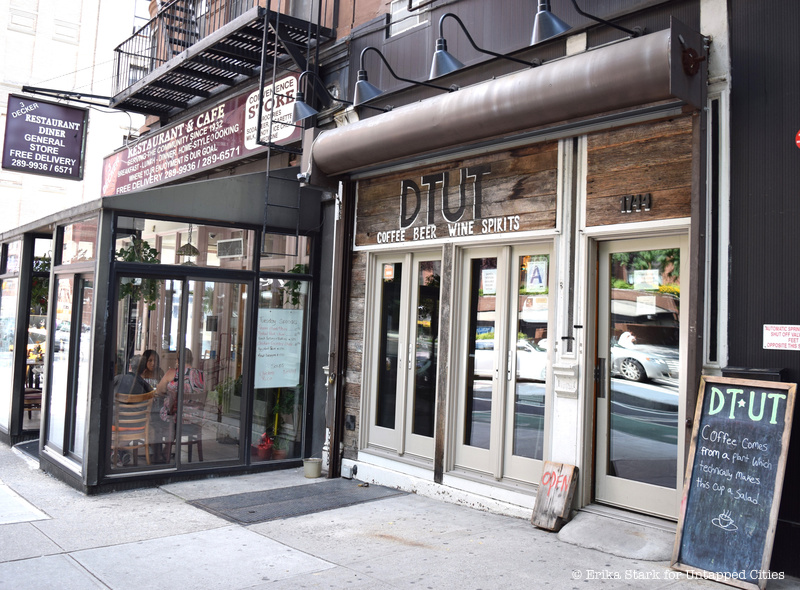
DTUT, a name meant to be a lose acronym for Downtown, Uptown, is a laid back coffee shop/bar that’s even relaxed in the pronunciation department (letting you choose whether to go with D-T-U-T or D-TUT– either will fly). Located at 1744 2nd Avenue, the idea of DTUT is to bring a downtown vibe to an uptown location and hopes you’ll join them pretty much everyday, at anytime between the hours of 9 AM and 2 AM on the weekends (with Friday opening at 8 AM) and then 8 AM till Midnight during the weekdays. Yes that’s right, they’re closed for just seven, healthy hours on those weekend nights.
In addition to serving good coffee, DTUT also supports local artists. The chandeliers are custom made and so is every mug– each one a unique piece that’s been hand-fired, glazed, and stamped by the same artist in the Hudson Valley. The bar is made from reclaimed wood, and the couches and armchairs are all vintage thrift finds. Similarly, its food menu is all sourced locally and seasonally– often changing to reflect whatever product is at its prime. But perhaps most important of all? The chance to enjoy chocolate fondue along the with a choice largest selection of American craft beer north of 86th street (as the DTUT website proudly boasts).
Non-Pretentious Private Clubs
Explorer’s Club
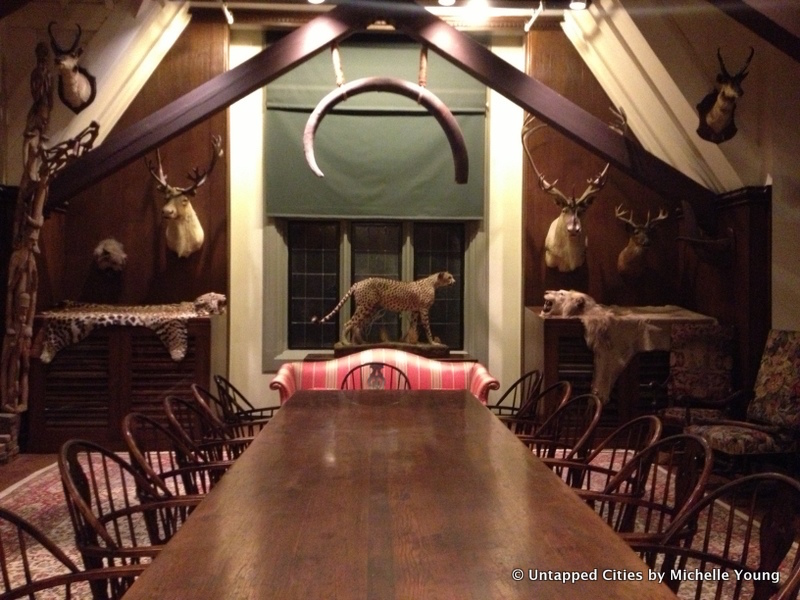
Located on the Upper East Side, The Explorer’s Club provides a certain sense of inclusivity you don’t normally experience at other member clubs, with plenty of public events. Even the gothic building that houses The Explorer’s Club gives a sense of warm and inviting history. It’s filled with artifacts from explorations by its founders and members, including Teddy Roosevelt, Neil Armstrong, John Glenn, and Edmund Hillary. It’s hard to argue with a club with a mission statement and pedigree as follows:
The Explorers Club promotes the scientific exploration of land, sea, air, and space by supporting research and education in the physical, natural and biological sciences. The Club’s members have been responsible for an illustrious series of famous firsts: First to the North Pole, first to the South Pole, first to the summit of Mount Everest, first to the deepest point in the ocean, first to the surface of the moon—all accomplished by our members. The Explorers Club mission is to advance field research, scientific exploration, resource conservation, and the ideal that it is vital to preserve the instinct to explore.
Organized by level of the building, walking through the explorer’s club takes you on a peculiar journey all the way from “sea-level” to “the summit.” Among the quirky artifacts on the way up is a floor filled with stuffed wildlife rejected from the Museum of Natural History, a wall of presdients, and an interesting 4 1/2 floor level.
For a more photos take a closer inside NYC’s Explorer’s Club.
Society of Illustrators (with its cool bar)
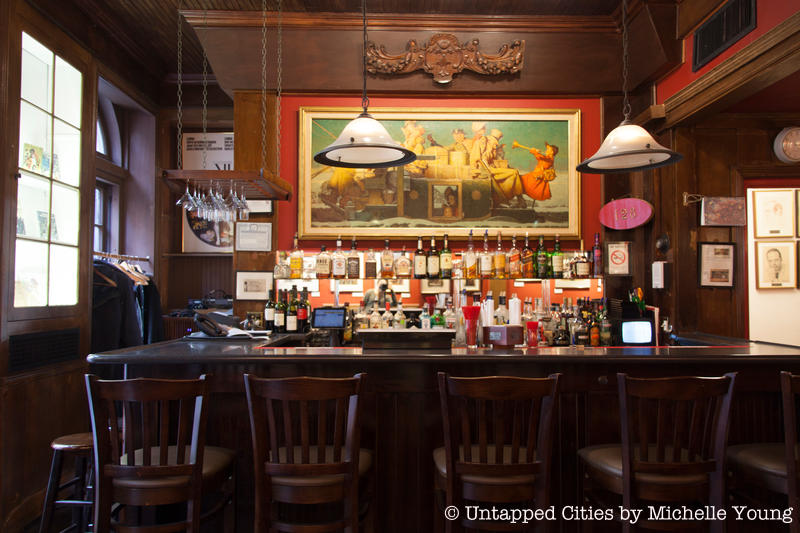
Founded on February 1st, 1901, the Society of Illustrators began with a very simple credo: “The object of the Society shall be to promote generally the art of illustration and to hold exhibitions from time to time.” This simple vision seems to have been beneficial, as the institution has remained true to itself for over a century.
In a modern context, the Society acts as a gathering place for industry folks and fans, celebrating the best in contemporary illustration through various gallery and award shows. Scholarships are given to students (they also hold an impressive show annually), there is a weekly sketch and jazz night, one can regularly attend lectures and screenings, and the bar and dining room upstairs, complete with an impressive original Norman Rockwell mural, is surely one of the most elegant in the city.
In addition to being the most important institutions for illustration, it is also an educational powerhouse with a collection that boasts 1,800 original works. All the greats are here, from N.C. Wyeth to Maxfield Parish, and the imagery is vast. Fashion, editorial, science fiction, children’s books–whatever the genre or market, it has a home here, and staff members are diligent about rotating displayed works frequently.
For images and more information on the society, read more about Untapped reporter, Kate Kelly’s, Behind the Scenes experience at the Society of Illustrators.
Next, check out our archive of “Must Visit” Guides in NYC.
With contribution from the previous work of Untapped Cities reporters: vera penavic, corey william schneider, benjamin waldman, nasha virata, jenna bagcal, agnes stanton, douglas capraro, michelle young, joanna ha yean shin, AFineLyne.





